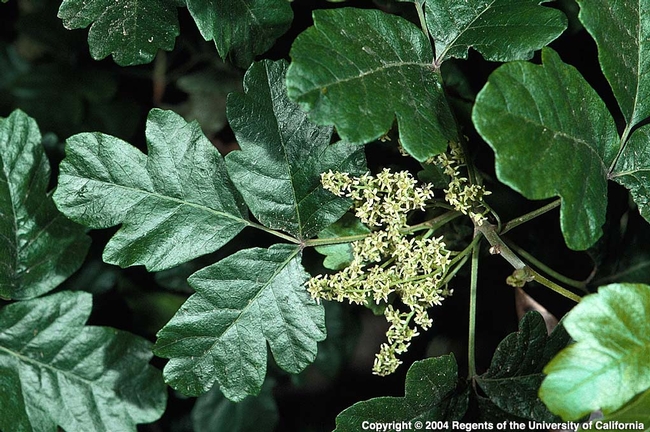POISON OAK
By Linda Lewis Griffith
Poison oak is native to western North America and is widely distributed throughout San Luis Obispo County. Poison oak can be difficult to identify because it grows in a wide variety of habitats and looks different depending on its location. In sunny, open areas, poison oak forms a dense, leafy shrub that stands 1 to 6 feet tall. In shaded areas, such as creek beds or oak woodlands, it becomes a climbing vine, supporting itself on other vegetation or upright objects using its aerial roots.
Leaves normally consist of three leaflets with the stalk of the central leaflet being longer than the other two. Each leaflet is 1 to 4 inches long and smooth with toothed or somewhat lobed edges. The surface of the leaves can be glossy or dull and sometimes even a little hairy. In winter the leaves drop off. The diversity in leaf size and shape accounts for the Latin term Toxicodendron diversilobum, meaning poisonous tree with many shaped lobes.
Poison oak is considered the most hazardous plant in California due to the annual number of working hours lost from allergic contact dermatitis after touching the plant. The allergic reaction occurs in 80 to 85 percent of the population and can lead to skin irritation, itching, and blisters. Transmission of the allergen can occur by direct contact with the plant at any time of the year. It can also happen by touching contaminated clothing, tools or animals, or by breathing the smoke of burning poison oak.
You can remove poison oak in your yard by physically pulling it out or grubbing with a shovel or pick. It's important to take out the entire plant, including the roots. Remove plants in early spring or late fall when the soil is moist and it is easier to dislodge rootstocks. Grubbing when the soil is dry and hard usually breaks off the stems, leaving the rootstalks to vigorously resprout. Detached and dried brush can still cause dermatitis, so bury or stack the plant material in an out-of-the-way location, or take it to a disposal site.
